What is biodynamic viticulture and why is it sometimes associated with dark magic or the occult? What’s behind the rise of English wines and how did two specific vineyards inspire a dark wine-drenched novel?
Over glasses of Pinot Noir and Rosé, wine writer Natalie Maclean talks to author J.F. Penn on the Unreserved Wine Talk Podcast about her folk horror novel, Blood Vintage, set in an English vineyard.
You can watch above or here on YouTube, listen to it on your favourite podcast app, or read the transcript below. We discuss:
- The rise of English wine, and how Woodchester Valley Vineyard in the Cotswolds, England, inspired the idea of a folk horror novel
- Biodynamic viticulture and how it plays such a huge part in terroir, and why Limeburn Hill Biodynamic Vineyard in Chew Magna, England inspired more the story
- Folklore and sensual writing, evoking a sense of place
- Exploring folk horror, and how far people will go for that special taste
- Wine and architecture
- Kickstarter, special editions, and the importance of beautiful packaging for what lies within — both for wine and books
You can find Blood Vintage at JFPenn.com/bloodvintage, and you can find Natalie at NatalieMaclean.com with articles, wine pairings and the Unreserved Wine Talk Podcast.
Transcript of the interview (lightly edited)
Natalie: What is biodynamic viticulture and why is it sometimes associated with dark magic or the occult? What’s behind the rise of English wines? Well, tonight you’re going to get those stories in insider tips and more with our guest, whom I’ll introduce momentarily.
I’m Natalie MacLean. I teach online wine and food pairing classes, and you’ve just joined one of the most passionate groups of wine lovers who gather every Wednesday at 7:00 PM to talk to the most interesting people in the world of wine and wine adjacent.
Alright, so back to our guest, J.F. Penn is an award-winning New York Times and USA today bestselling author of horror, thrillers, dark fantasy, crime, and travel memoir, as well as short stories. She’s also an award-winning podcaster. Her podcast is amazing, by the way, The Creative Penn. I listen to it every week and you should too if you have any interest in books or reading.
She has a Master’s in Theology from the University of Oxford and her latest novel is called Blood Vintage, a folk horror story set in an English vineyard. I just finished reading and it’s wonderful, Jo. You are joining us now from your home in Bath, which is nestled in the beautiful countryside of Somerset, England, about a hundred miles west of London.
Welcome Jo. I’m so glad you’re here with us.
Jo: Oh, I’m so excited, Natalie, it’s an excuse to drink wine with a friend.
Natalie: Alright, so before we dive into your book, tell us about the pinot noir tours and festivals in the South Otago region that you attended while you were living in New Zealand.
Jo: I lived in New Zealand for six years, so 2000 to 2006. It was one of those, mid twenties, go backpacking, fall in love, stay, get married, get divorced, get remarried. You understand all this!
Natalie: Oh wow. You’re busy.
Jo: Yes, exactly. But I did a Pinot Noir tour in South Otago, and it is quite a famous region for the Pinot Noir grape. I wanted to tell you about two particular vineyards. One is called Mount Difficulty, which is a wonderful name in that region because the mountains, the Remarkables are really high and it’s a pretty hardcore walking region, skiing region in the winter.
And the other one is called Peregrine vineyard and it’s a beautiful region for nature, but Peregrine have created this incredible architecture. The roof of the winery is shaped like the wings of a peregrine, and I particularly remember that tour. It’s out of Queenstown in the south of New Zealand.
It gets very cold in the winter, but highly recommended. And you are the best at pairing, but I was going to put it with New Zealand wild venison, which is something you get a lot of around there. But you’ve tasted the New Zealand Pinots, right?
Natalie: . Oh, I love them. New Zealand is better known for Sauvignon Blanc, but I think the pinot noirs are even more spectacular. They’ve got this nervy, edgy acidity that I love. It’s almost like the wine vibrates in your glass and it’s so food friendly because acidity is to wine, salt is to food. It brings forward flavor, but gorgeous, gorgeous wines.
Jo: Absolutely. Since you mentioned the Sauvignon Blanc, I also wanted to recommend a very specific New Zealand oyster as a pairing with that, which is the Bluff oyster. And I think you like oysters, right?
Natalie: I write about them. The one thing I can’t get past, it’s a texture thing.
Jo: Okay. Well, for people who love oysters who are listening, I love oysters. I’ve eaten oysters all over the world, and the Bluff oyster in New Zealand has a very short winter season.
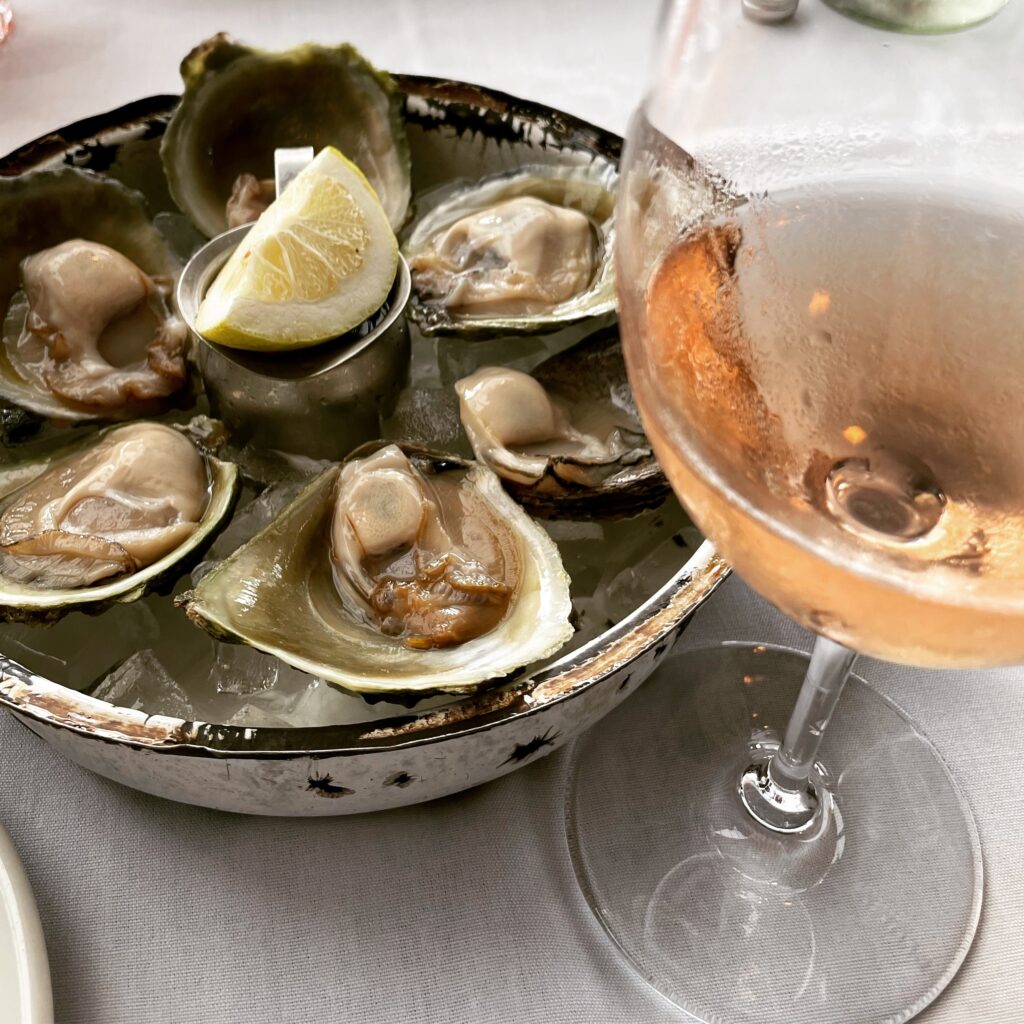
But it is incredible. To me, it is the best. And I have a vivid memory of drinking a Sauvignon Blanc with a Bluff oyster. Well, maybe dozen oysters on the lake there, Lake Wakatipu in the winter sun. I highly recommend that pairing. And it’s very hard to get them anywhere else in the world.
Natalie: Oh, wow. Well, I’ll have to make a note of that. My husband likes oysters. I love that great evocative image there, that carries through with your book.
Let’s set the stage for your book, Blood Vintage. You did a serious amount of research into biodynamic wine making and wine making generally. Before we talk about that, maybe share the overview of the story with us, please.
Jo: This is a special edition, so I shall read it for you.
The perfect vintage requires the darkest sacrifice.
In the rolling hills of Somerset, England, an ancient evil ripens alongside the grapes of Standing Stone Cellars.
Rebecca Langford never expected her architectural career to lead to the secluded rural village of Winbridge Hollow. But after a violent clash with eco-activists, she flees the chaos of London, desperate for a new start.
She seeks refuge at Standing Stone Cellars, a vineyard renowned for its award-winning wines and mysterious history nestled in the shadow of ancient oaks and standing stones that have watched over the land for millennia.
But this vineyard is no sanctuary.
From the primal fires of Beltane to the chilling shadow of Samhain, Rebecca finds herself ensnared in an ancient cycle of sacrifice and rebirth. The disappearance of her fellow workers amidst evidence of blood rites forces her to confront a horrifying truth. Standing Stone’s exceptional vintage is nourished by more than just sunlight and soil.
As the veil between worlds grows thin, Rebecca must make an impossible choice. Embrace the dark legacy of the vineyard and secure her place amongst its guardians, or risk becoming the next offering to the insatiable Horned God that demands his due.
Blood Vintage is an atmospheric descent into folk horror where the line between sacred and profane blurs with each sip of wine. Lose yourself in a world where pagan ritual and modern ambitions collide and discover the terrible price of belonging. In a place where the very earth demands blood.
Natalie: Ooh, I love that. That is such a great description that really captures it. So atmospheric. So dark and brooding. And yet bonus for us who love wine. Wine is running right through. So before we dive into that, I’m itching to get there. You selected a wine to pair with your book as have, so let’s hear about yours first. What is it?
Jo: Yes. The Blood Vintage itself would be the Samhain wine from Limeburn Hill Vineyard, but that’s really hard to get.
So I’ve gone with the Pinot Rosé from Woodchester Valley, which is where the original idea for the book came from. I love a rosé and we’ll obviously talk about where this has come from. I have my glass ready. This has been chilled, but yes, Woodchester Valley Pinot Rose. It’s a hundred percent Pinot Précoce, the early pinot noir.
Natalie: Right. Oh, lovely. I love a rosé. I’ve chosen a more brooding, darker wine for you and your book. This is from Italy because we just don’t get many English wines here in Canada. But this one, the label has a woman and her hair is in flames because fire is a metaphor, but also the sun and stars are all around her.
It comes from the Donna Fugata winery in Italy, which means fugitive woman, woman on the run. [In Blood Vintage] Rebecca is running a little bit from her architectural career, and she’s escaping out to the countryside with the vineyards. Anyway, lots of metaphors, but I love the labels on this. Let’s have a sip to get going here.
Jo: Cheers.
Natalie: Oh, you have a goblet there?
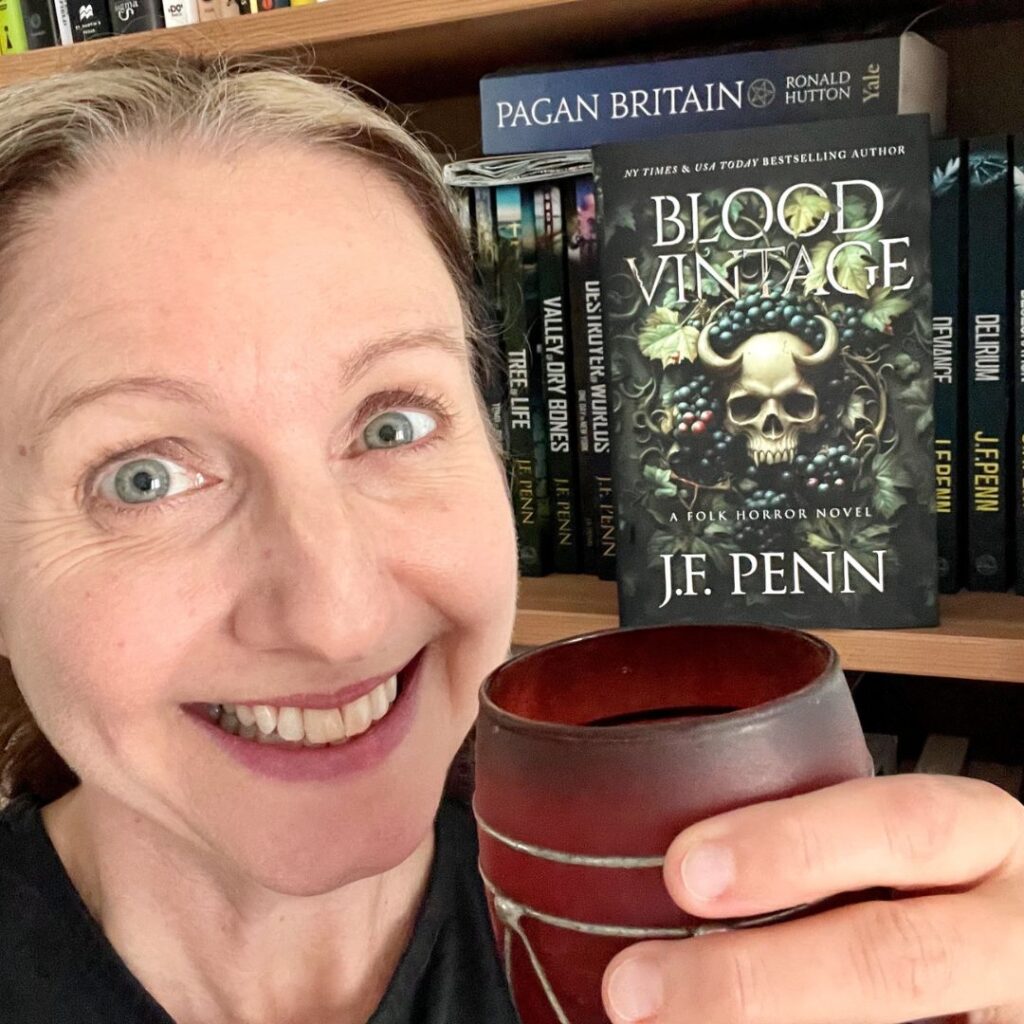
Jo: Yes. My special glass. I bought this 20 years ago. I was in Prague with a friend of mine. It was the winter, and I saw these glasses. I drank a lot more red wine at the time, and I was like, this is perfect. I love these.
This is one of those times where I’m backpacking. Do I really want to take glass anywhere? But we had such a lovely trip and these memories of drinking together are important. So that’s the story of the glass. I know it’s not perfect for rosé.
Natalie: Well, we’re not gonna get technical here, but for those who want to know, an ideal glass is clear and has a big enough bowl so that you can swirl it. But I love the goblet. Very atmospheric, very Blood Vintage. Very gothic.
Tell us what drew you to this story in the first place. Like where were you?
Jo: Oh wait, I haven’t had a sip yet. Mm. It’s really tasty. It’s very strawberry. You are much better at these tasting notes than I am, but I can definitely taste strawberries.
Natalie: Strawberries, absolutely. That is the essence of a good, fresh rosé. It makes your mouth water. It’s like field berries, sunshine, and, well, kind of the opposite of the mood of your book! Although your book is not a downer, it’s just very gripping and thrilling.
Where this idea came to you?
Jo: Yes. So Woodchester Valley is a small vineyard. Most of the vineyards in England are smaller, although they’re getting bought up as many of these things do.

But this is a small one and the Cotswolds is in the southwest of England. It’s an Area of Outstanding National Beauty, which is like a distinction of certain areas and you would absolutely recognize it. It’s the kind of chocolate box England with the green rolling hills, lots of green ’cause it does rain, but also sunny. There are lots of stone buildings. Cows wandering around. It’s kind of pastoral, but also enough hills. [We cycled from Oxford to Bath through the Cotswolds, pictures here.]
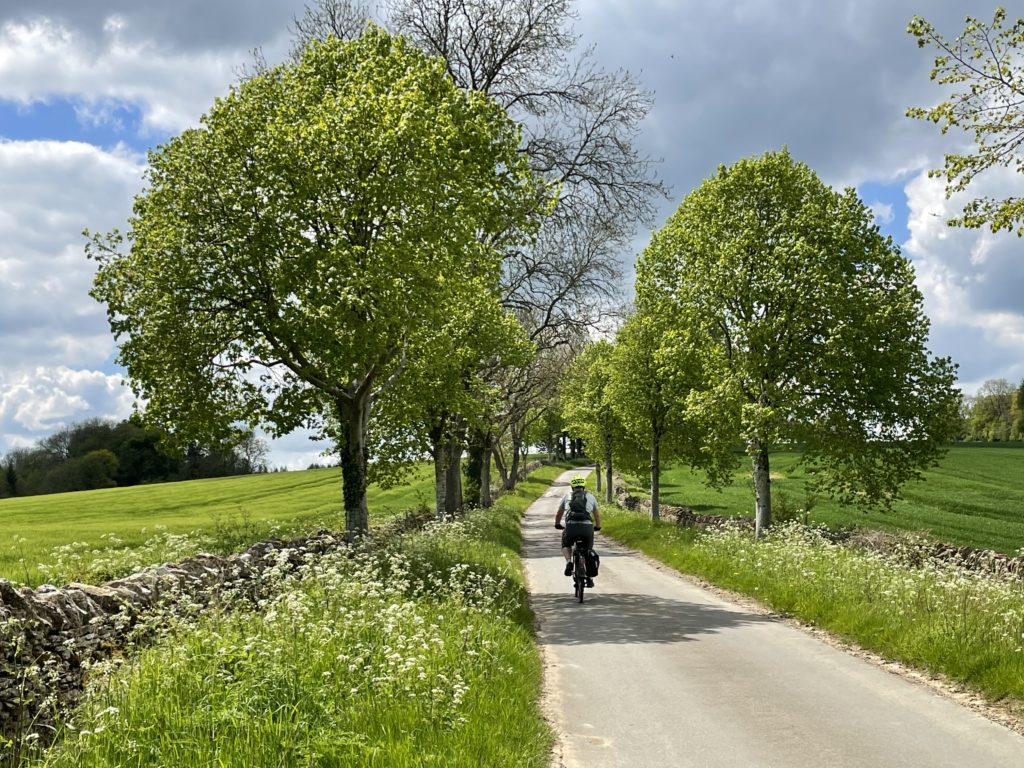
And Woodchester Valley. I went with my dad and my stepmum and my husband drove. So my dad and my stepmum and I drank and we went to the vineyard. It was July. So the grapes were the tiny little green bits. They weren’t full yet. Excuse my language, which is not perfect.
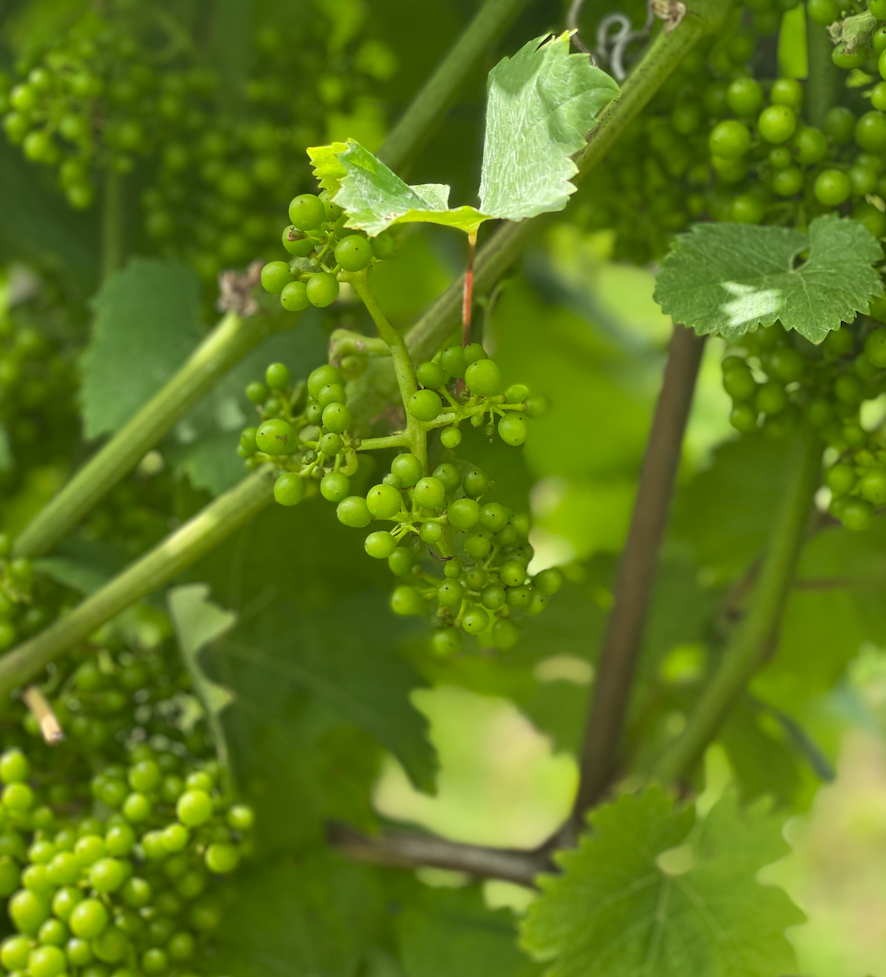
Natalie: That’s okay. But you know what? You are a fiction writer, not a wine writer.
Jo: I describe it better in writing than speaking words.
But anyway, we went there for a wine tour and one of the first things they said was this area of vines was south facing and it was beautiful, and they told us about the frost candles, the bougies, I think they’re called.
And the vision in my mind where in the winter they get these beeswax candles, they’re very good for the environment and they put them in amongst the vines to stop the frost and to stop them killing the bud break, I think it’s called.
And I was like, oh my goodness. In my mind I could see the frost candles and I had a story going off in my brain. So that was one thing.
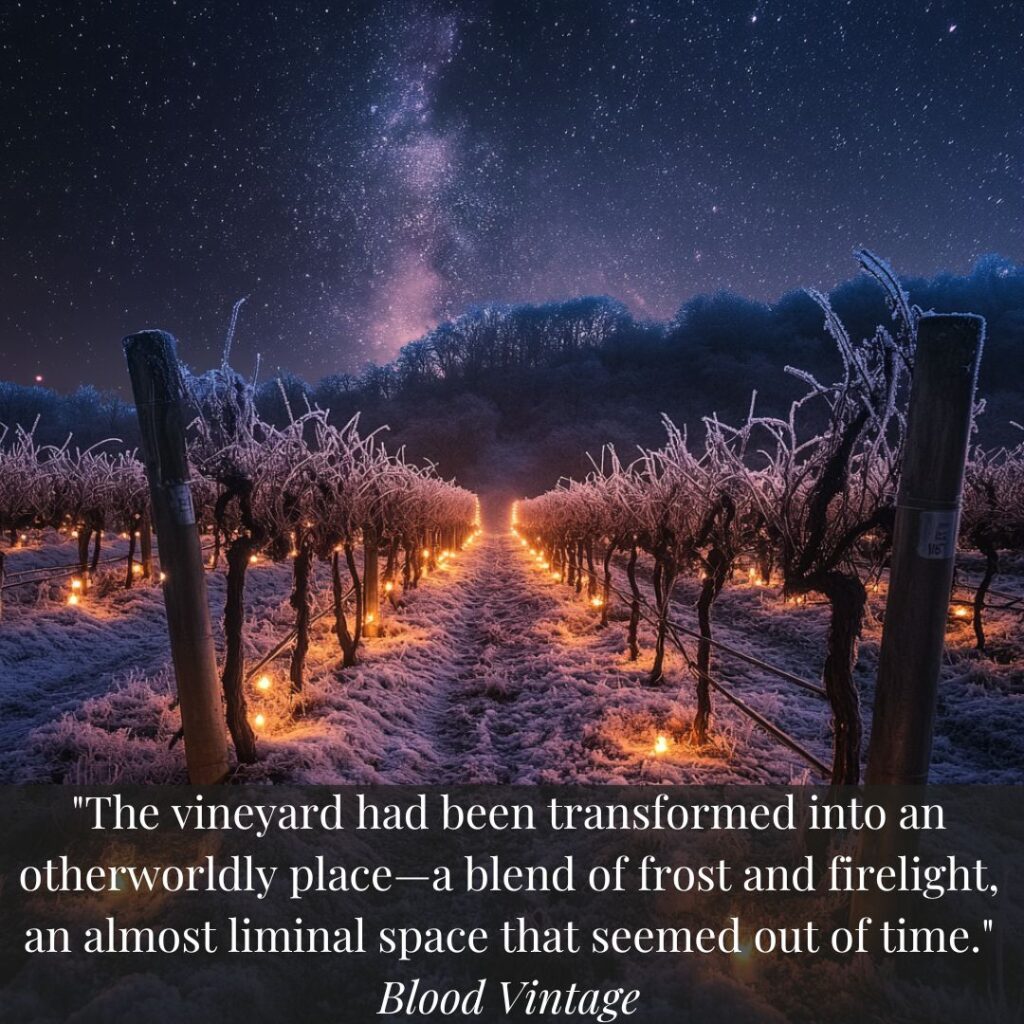
We walked past the crushing equipment and the bottling thing where they do the Pet Nat, I think it is, and they turn the bottles and I was like, oh, that could explode.
Then they told us about this ancient part of the vineyard that they own where we couldn’t visit. And I was like, oh, I’ve got to know more about that. It’s owned by a female vineyard owner, Fiona, and she found a mention of this area in the Doomsday book. So if you don’t know, it’s an 11th century document that was essentially a tax record so they could tax people on land. And there’s a vineyard in this area from the 11th century.
And so I was like, oh my goodness, and then of course, the Romans brought vines to this area. So in my mind I was like, there has to be some ancient ritual in this place. So that’s where the idea originally came from.
Natalie: Oh, that’s marvelous. I mean, you’re already painting a picture with all those visuals and the mystery, the history, everything.
Say a little bit more before we continue about the rise of English wines.
With climate change, a lot of marginal wine growing regions are getting warmer and therefore it’s easier to ripen grapes. As I said, we rarely get them here in Canada yet, hopefully we will in the future. How large is the industry?
Jo: As you mentioned, it’s climate change. They told us this in the Woodchester tour, is that the climate here now in the south of England is the same as the Champagne growing region in France.
It’s English sparkling wines that are winning the awards. What’s also interesting is French vineyards are buying up land and vineyards here in England because there’s obviously as climate change happens, they are looking for new vineyards.
I did look up the numbers. It’s eight to 10 million bottles out of the UK and around 800 vineyards and I looked up Canada, so you are 60 to 70 million bottles. So we are like a sixth, a sixth of the Canadian market. But obviously you’ve got a much, much bigger country.
Natalie: We do, yes.
Jo: But compared to New Zealand. New Zealand’s a tiny country and has a huge wine industry, a lot bigger than both Canada and England.
I’m kind of hoping that over time one of the ‘benefits’ I guess of climate change might mean more English wine. But now if you go to English pubs and wine bars, you can buy English wine. It’s in the supermarket. I hope that you can get some over there.
Natalie: Yeah, that’d be great. And I’ve heard they’re even planting vineyards in Scotland these days.
Jo: And there’s a biodynamic vineyard in Wales as well, near where I am. But just to come back on the Romans, ’cause I think this is really interesting for people and why the spirit of the land is so important here, is that the Romans brought vines here between 43 AD and 400 AD. 1600 -2000 years ago.
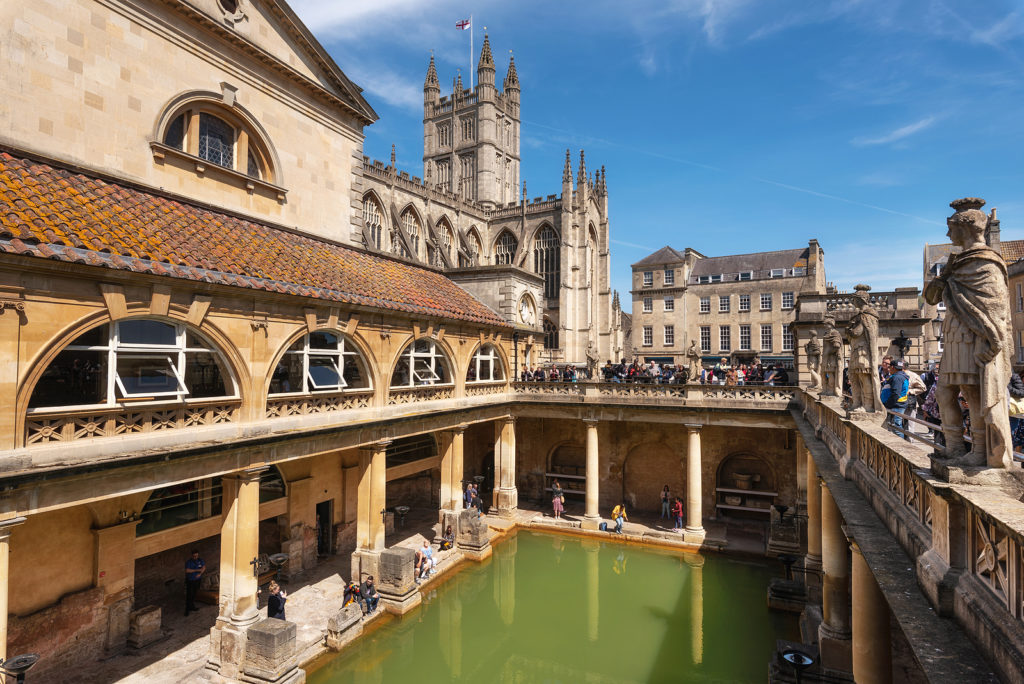
Where I live in Bath, it used to be called Aquae Sulis. We have 2000 year old Roman baths in the centre of my city. The land where I stand and where these vines are and where the book is set, they’re kind of this ancient history that’s now coming back to life, I guess.
Natalie: Yeah, all the ancient relics being discovered and buried in some of these vineyards and so on. So, back to your story at Woodchester Valley. So they mentioned you couldn’t go in that part of the vineyard, which of course immediately sparked curiosity and probably the desire to go in that part of the vineyard. You also said it reminded you of a performance of The Bacchae maybe. Tell us about that.
What’s the connection to The Bacchae?
Jo: Yes, and of course my dad and me and my stepmum, we drank a few of the wines. We tasted in a proper way, no spitting, so that might have helped!
It’s funny how these memories come back to you. I remembered a performance of The Bacchae, which is an ancient Greek tragedy. Many thousands of years old. Bacchus Greek God of wine and fertility and all these kind of wonderful things. The worshippers of Bacchus (Dionysus), in a rite, they go mad essentially, and they rip apart a man instead of a deer.
And this kind of gave me another thought about these pagan rituals that go on around wine. And again, in our western society, we have Christianity and Judaism, both of which use wine in religious ritual.
Using wine in religious ritual as a sacrament is normal for most people. But in terms of taking it further into where you are on a different plane of consciousness, I just thought this was a super interesting thing. Also, the fertility stuff and the, the vines and wild nature. I love wild nature!
I think it’s fascinating. I mean, you’ve been in these vineyards all over the place and it’s the wild sections that I find really interesting ’cause they might be all manicured in places, and then there’s these kind of wild bits that are fascinating.
Natalie: It’s a perfect symbol for the balance in life between restraint and thinking and the wildness of nature and the body, the mind versus the body. I mean, all the metaphors are working for you in this one. That’s fantastic.
Where were you watching that play? It was back when you were a high school student, right?
Jo: Yes. And I think that’s why it’s funny when these memories emerge. You think about something and it sparks something else.
I studied ancient Greek and Latin and Classical Civilization when I was 14 to 16, and then I went on and did theology and reading ancient Greek was very useful. We went to see this performance at an actual replica of a Roman amphitheater with a proper, and it was performed in ancient Greek.
And I still remember it very vividly. It was in another school, and it’s one of those occasions where you think if I was watching it now, I’d be very cynical and I’d be like, that’s a bit crap. You know, it’s like school kids doing a performance. But in my mind and in my memory, it was so powerful to see what happened in this ceremony.
And so it really stuck in my mind. I have another podcast called Books and Travel and I interviewed a vintner, Caro Feely from Chateau Feely in France. And she was telling me about all the different ways that you can get injured and die in a vineyard.
And that kind of came into my head as well, that all these things mush together. You know, you are a writer.
Natalie: Yeah, for sure. And they pop out at time. Then one thing will spark another, and wine itself, it’s all about the smell. And so smell is tied to memory. It’s going to touch off like a spark point of bringing right back to a place or a time. It’s very powerful.
But, okay, you just said, she was talking about all the ways to die. Wine lovers also have grim imaginations, especially if we’ve got a bad bottle or something. But tell us about all the ways you discussed with Caro about the ways you could die in a vineyard, so we know what to watch out for in our next trip to a winery.
Jo: Well, it was the idea of blood. I mean, you can get cut on quite a lot of these equipments, you know, pruning things and the machines that go through the vineyard if you use them, and I mean even the glass and shattering of glass, the bottles.
Natalie: Obviously sparkling wine can explode in the cellar.
Jo: Yes. And in fact, that was one of my rewrites was the exploding of the wine that gets turned in the riddling rack, I think it’s called, isn’t it?
Natalie: Right, it is, yeah.
Jo: Which is cool. And then in those wine barrel rooms, one of those could slip and there’s some of those are super heavy barrels, you could definitely get crushed under.
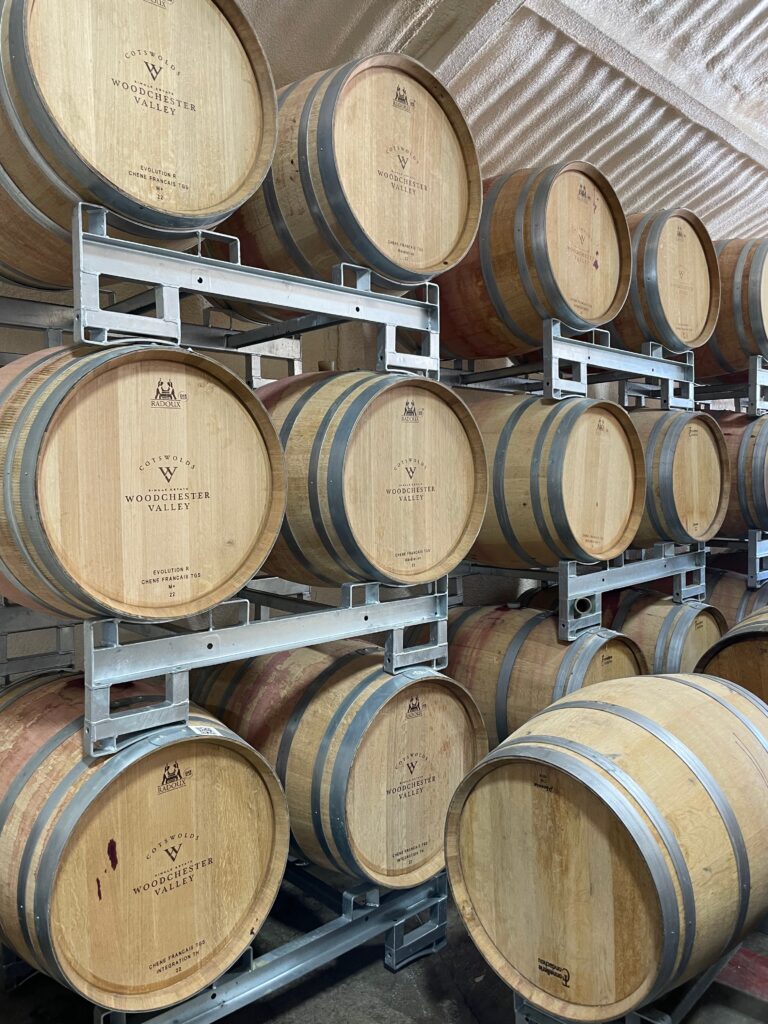
Natalie: Absolutely. And people have been known to fall into vats and not drown, but actually asphyxiate because it’s all CO2 and it’s quite deadly to be around a winery. I never thought about it that way, but you’re right. And the bottles, they can explode because they’re under pressure.
The bubbles create the pressure. It’s 90 pounds per square inch. It’s the equal to city bus tires. It’s going under a second fermentation, adding more and more pressure under that glass. So if that’s not solid, you get exploding bottles for sure.
Jo: It’s very interesting because obviously I’m an author and I sit at my desk and I don’t have much that can kill me in my day job, but I just love researching all this, and I think one of the things that really came home to me in doing this research and going to vineyards was — it’s such hard work. Like it’s seriously hard work.
There’s this romance about, ‘oh, when I get rich I’ll just have a vineyard or whatever.’ And it’s so much work. And then also so much investment in all the equipment and all the things you need. I think that really, it sort of impressed upon me how difficult it was, but also how tired these people must be during the harvest time and all that. So be careful out there in your vineyard.
Natalie: Absolutely. And we share personal trainers, and this is just bringing to mind the hard physical work of a vineyard. I always thought you could design a workout program around wine, so you’d have like abs of stainless steel.
Jo: I’ve got a bit of a workout here on my arm. [I’m drinking the wine!]
Natalie: Yeah, that’s right. That’s deltoids, right. Thanks Dan (our trainer).
You live an hour’s drive away from one of England’s few biodynamic vineyards, Limeburn Hill. Tell us about that.
Jo: Yes. This is really special. Limeburn Hill Vineyard is biodynamic and it is certified. I know you’ve had someone on the show to talk about biodynamics quite recently. In fact, I was listening to that earlier.
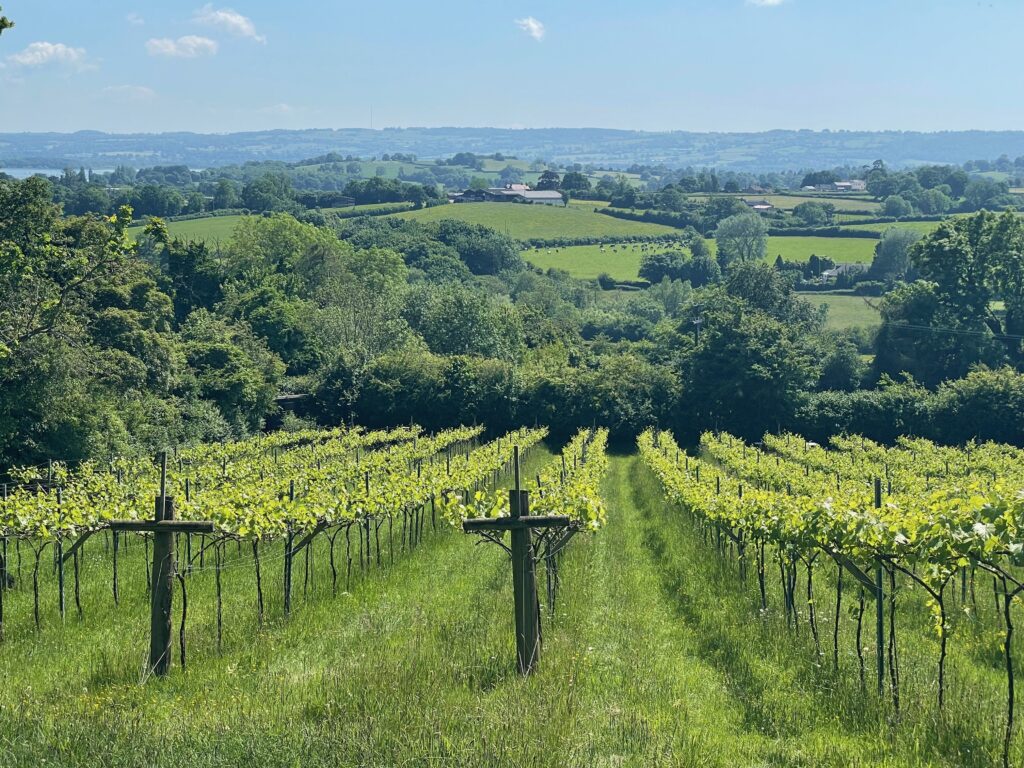
It is in the Chew Magna area near me. It’s limestone. The Romans were working in that area, so again, very ancient land. It has 3000 vines, hand planted. Limeburn Hill is run by a couple, Robin Snowden and Georgina Harvey and I went and spent a day there. I did a course on Biodynamic Winegrowing and it was full of wine people. And then I was like, I’m writing a novel.
And Robin was very patient with me and, and especially when I said, ‘oh, where do you bury the bones?’ He was like, okay, I’ll show you.
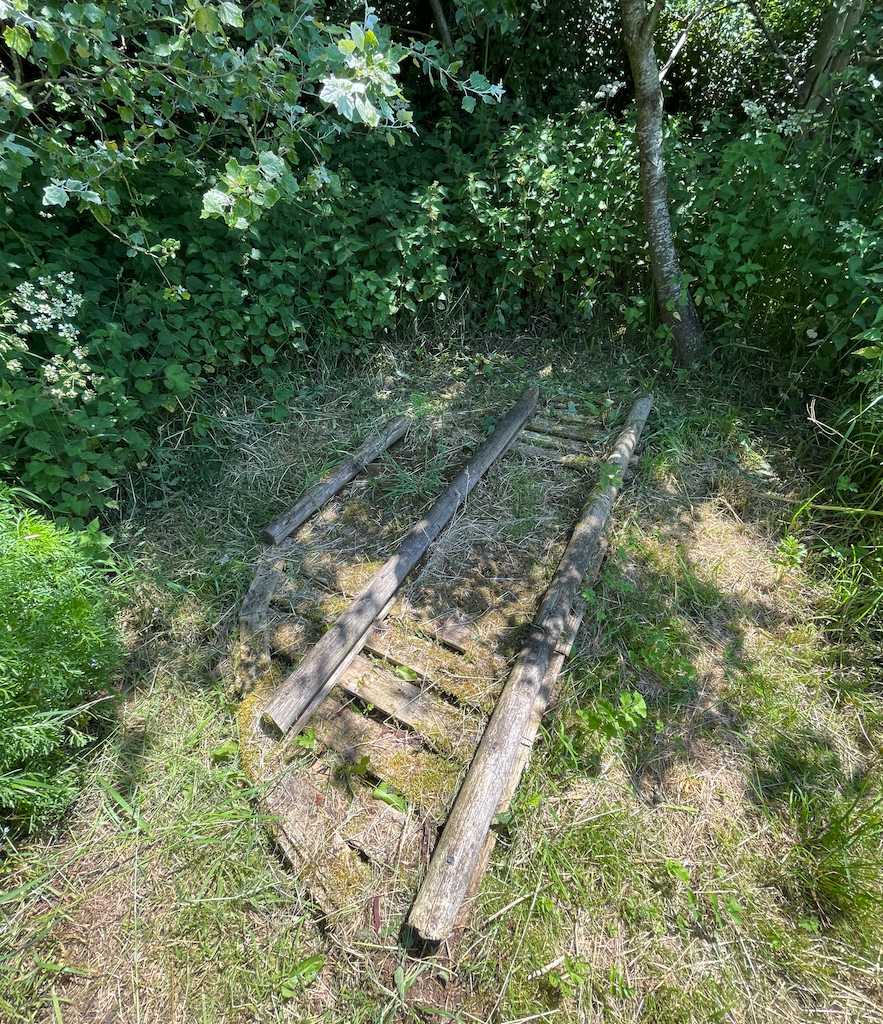
Their wines are the Pet Nat.
Natalie: Pétillant naturel, so it’s a light fizzy wine.
Jo: Fermented in the bottle. They have three wines named after those festivals, Beltane, Lammas, and Samhain, so these are Celtic festivals. One’s a white, well, kind of orange, one’s the rose, and one is the red, Samhain, the winter wine, which I think is pinot noir.

And so I went there and I saw these wines and that gave me ideas, but then also they explained what biodynamics is and the Rudolf Steiner method, the holistic view of the vineyard as a contained ecosystem, and they were taking this very, very seriously. They had wild bees because it’s all the natural yeast in the area. There’s no extra stuff.
They have these little sheep that run around eating things. They have wild flowers.
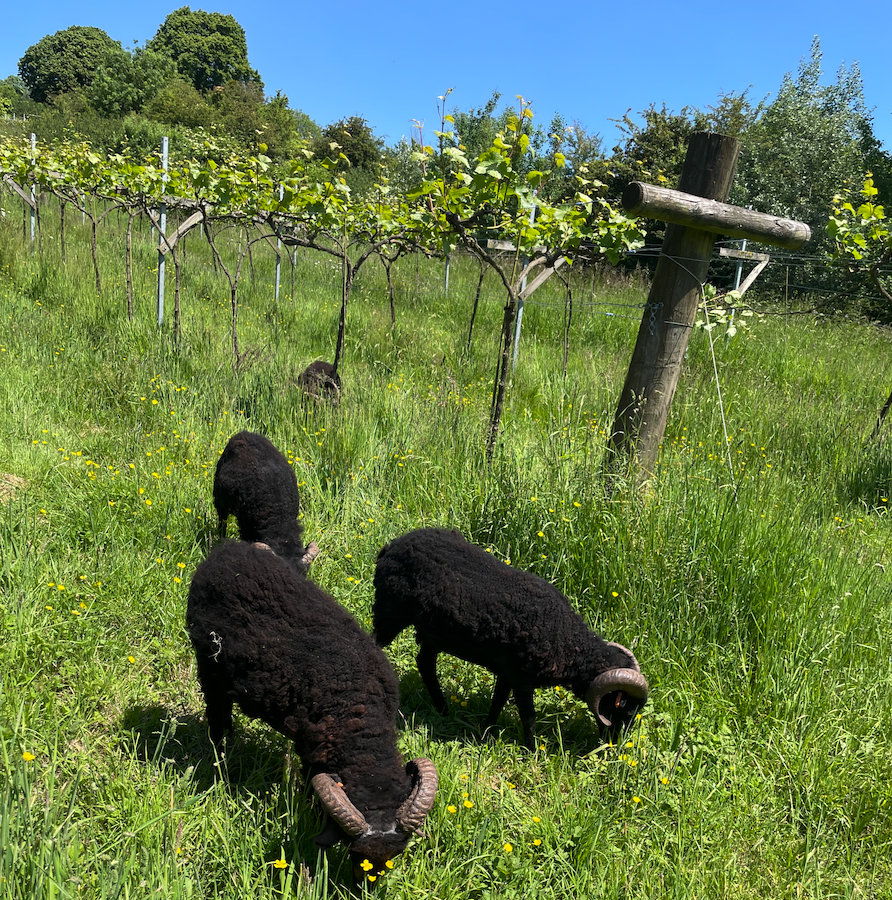
I was super impressed by, again, how much work this is, but also the ecosystem of the land. It was beautiful. It was so beautiful, a wonderful day. And again, the sort of romantic idea, but he demonstrated the dynamizer they call it, which is a stirring thing where they stir for a minute in one direction and then the other direction.
And he had the books out with all the sun and the moon and the planting and the energies that go into it. And this was all just fascinating to me. So, that is Limeburn Hill Vineyard. They do tours and courses and things. Their wine is very hard to get. It’s served a lot of independent restaurants, fairs and things like that, but they’re fascinating.
I should say there was no sacrifice, no blood sacrifice!
But they did honour the land. They had an area which was a sacred grove.

And obviously there is the place where they bury the horns and I mean, there are some preparations with skulls and things, so it’s just some weird stuff going on in biodynamics, but fascinating.
Natalie: Absolutely. So just say a little bit more, if you remember it from your course, they bury the horns and the skull and things in it?
Jo: Yes, so Preparation 500 is the cow horn. So each of these preparations are made from either animal parts, so stomachs, bladders, intestines, skull, and then you fill them with manure or certain plants like yarrow, chamomile, different things, and that should be growing on your land as well. It’s all a contained ecosystem.
You bury the horns in the winter, and the skulls (Preparation 505) you put in this wet place, like under some running water, and then after a certain amount of time, it changes, it gives you stuff like some compost, and then you put that in the dynamizer and you turn it into like a tea, and then you spray it on either the roots or the leaves or whatever you need. They also use quartz — and if anyone listening is like, oh, she’s butchering this!, Sorry.
What’s so fascinating is you might think, oh, that is just weird, like strange, strange stuff …
When you think about the vineyard as an ecosystem and the real terroir, the sense of place that they’re trying to just put into every single drop of the wine, well, why would you bring in something from the outside, right?
And then the natural way of making these sprays and these treatments, and Robin was saying very much that you go out and you get to know the vine and you look at it and you are like, okay, this needs some more moisture or this needs some more whatever, and then you use the preparation that will go with what the land needs, and it can take a long time to get the land back up to what it should be.
In fact, he said there were no worms in the soil when they bought the place.
Natalie: Wow. So it was dead. The vineyard was dead, the microbial life was just dead.
Jo: Yeah, exactly. And it took them several years, although I think he said it was quicker than expected until the earth is just chockfull of worms.
Natalie: It’s like the vines had to go to rehab and get off their drugs, their fungicides and pesticides.
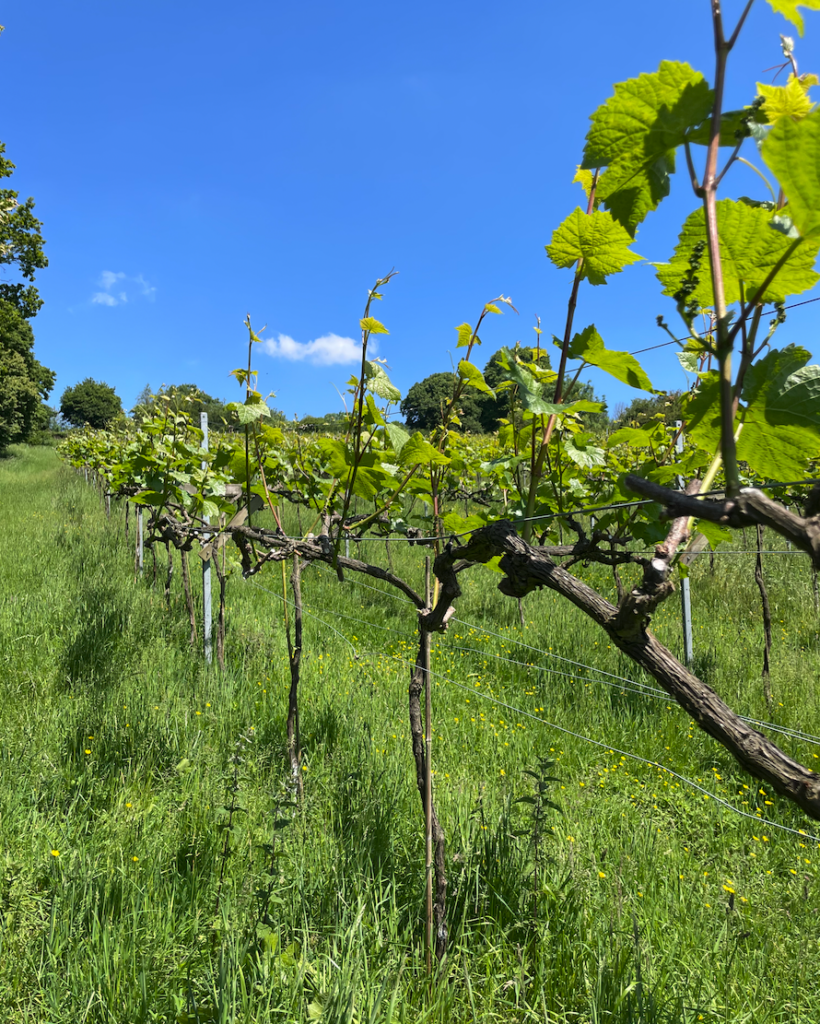
Jo: Yes. Well, that’s the thing. And well, they planted that vineyard, so I guess they got the vines and put them there. But I just thought that was fascinating because the idea of the land itself is what I’m so fascinated with.
How we feed the land, to make the land then feed us. This is something that just really interests me.
Natalie: Absolutely. And, you know, for whatever you believe with the, the astrological signs and some of the aspects of biodynamics, I think it can’t be faulted overall because it means that those who engage in those practices really have to pay attention, as you say to the land.
They really have to look at each vine almost individually and say, what does this need? And the more closely you pay attention to vines and wine making, the better your wine will be, as opposed to mass harvests and mass spraying like some vineyards that are not even organic, which is a step down from biodynamics are sprayed 25 times or more over the course of just one vintage. So, I’m all for biodynamics.
Jo: Well I did want to ask you on this because I did some tasting. I was driving, so I did spit, and it was very unusual. It was a very unusual wine. And of course every single bottle is different, not just every vintage is different. Given you are a better taster than me, how would you describe the difference between a biodynamic tasting wine and the wine I’ve got here, the Woodchester, which is not biodynamic?
Natalie: So you have regular wines and then you have organic, you have biodynamic and everything that organic wines are biodynamic must be plus plus plus. There’s not gonna be as many sulfites, preservatives, in organic or biodynamic is regular wines, but I think we exaggerate just how sensitive we might be.
It’s only about 5% of the population that are really sensitive to sulfites and a glass of orange juice on average has more sulfites on average than a whole bottle of wine. So one major difference though will be the sulfite content, but apart from that, I think, in a blind tasting, I’m not sure that I could say that’s a biodynamic and that’s, unless I was comparing a really mass commercial market kind of wine that’s made like breakfast cereal.
But then they’re gonna be a two very different price points and you’d have to control for all the factors. You’d have to have the same grape, the same region and compare this vineyard wine biodynamic to that one that is not. But so I doubt that I could really differentiate them other than I would hope the biodynamics, they can be funky and a little weird.
Jo: Yes. Funky is a great word.
Natalie: Then you start to veer into another category that’s not defined at all, at least legally. Natural and raw wines, which are not the same. Just like all stallions are horses, but not all horses are stallions. I can pick out sometimes more obviously what is a natural wine ’cause it will have no zero preservatives and just yeah, sometimes it can get quite funky.
Jo: Yeah. I do remember it as being interesting or funky, like you say. I mean, I think you have to be very open to new things to try that. It’s not like, oh, here’s my favorite rose, or here’s my bottle of Prosecco on a Saturday night or whatever. That’s not that kind of wine.
I did want to mention a book called Voodoo Vintners: Oregon’s Astonishing Biodynamic Winegrowers by Katherine Cole, which is about Oregon’s biodynamic vineyards. I used that heavily in my research and again, fascinating. The Demeter USA is the certification board and it’s incredible how high the standard is.
There’s a lot of places using biodynamics, but they’re not certified because it’s such a high, high standard. I just encourage people, ’cause again, I’m not a taster like you a super taster, but to try these different wines. It is very, very interesting and supports the vineyard. It’s very hard to have a business as a small vineyard.
Natalie: It is. They’re small, generally small family farms. And there’s no scale or economy of scale. I mean, there’s, there’s a few big conglomerates in each country. But, the other thing is that they say on average, organic viticulture costs you 15% more and then biodynamic another 15% on top of that. Because you can’t resort to pesticides, fungicides, and insecticides. So, it is definitely worth seeking them out.
Jo: Limeburn Hill does courses. They do weekends, they do hen dos and stuff like that, Woodchester has accommodation as well, so you can stay there actually in the vineyard. I think that’s really nice. It’s like I can spend more money in a vineyard by doing activities. You don’t have to go and do a tasting. You can actually do tours or stay places.
Natalie: Absolutely. Wine travel is just burgeoning because, as you say, you can taste the wine, but often there, there’ll be a restaurant attached to the winery or restaurants locally that’ll do wine and food pairings for you. But wine tourism, there’s all sorts of things to do from spas to ballooning to biking. That’s really interesting.
What was the most surprising thing that you learned about biodynamics or wine making or wine itself while you were writing the book?
Jo: I think I’ll come back to how hard people are working, and how badly wrong it can go. I think when I wrote the scene about the frost in the vineyard, I really understood as I was researching that this can destroy a huge proportion of a crop. There are things that can go horribly wrong that can just destroy the whole thing.
And I know that can happen with other farmers, but often other farmers have other crops going on. These vineyards, they really only have the one. So it was incredible to me how on a knife edge it is and how you have to look after them.
There might be a swarm of insects or it might be something like a flood, there’s so many things.
Also, again, how much variability, I think as someone who enjoys wine, but has perhaps just taken it for granted. Like I can just go and get a bottle of rosé or whatever, and then you see the variability between the areas. So again, these vineyards are about an hour and a half apart in a car. In the big scheme of things, they’re not that far away, but they’re really very, very different. That idea of terroir really came home to me, but I certainly am taking viticulture a lot more seriously now than I did before.
And I hope in the book, I mean, it’s not a book for viticulture people, it’s the setting, but I do care very much about my research.
Natalie: It’s fused throughout. You do it so well, but you are right. People have that dreamy vision of owning a vineyard, but really it’s fancied up farming. It’s hard work and callous hands and sunburn and all the rest of it.
It’s not something that is just portrayed on wine labels and wine advertising. It really is grassroots hard work.
Jo: The passion of it is incredible, but also it makes you think a lot more about what wine is. I know you talk about this, that there’s a lot of myths and there’s a lot of bad stuff that goes on and a lot of amazing stuff.
But at the end of the day, it’s about having a glass of wine with a friend or as part of a group or your family.
Like my family are drinkers. So wine plays a big part. In fact Woodchester, it’s just down the road. We do get wine from there. And that’s what it’s about. The times we have with wine for most of us whose job it isn’t.
Natalie: Absolutely. It’s the drink of conversation. It’s meant to be consumed slowly. It’s why we don’t serve wine in shooter glasses and just knock it back. Although sometimes maybe you feel in the mood for that, but really it is about communion and joining people together over conversation.
You’ve mentioned terroir a few times and in the book, I counted 17 mentions.
What does terroir mean to you?
Jo: I think it’s a unique sense of place based on the geography, but also what’s under the earth. I learned a lot about the limestone that this area is on and how that affects the soil.
I didn’t know anything about soil before this. The weather. The rain. What happens with the sun? Like what direction the slopes are on? You don’t buy a piece of land without considering where you are planting the grapes.
What you feed the soil, obviously, and I loved it, Limeburn, they let the wild flowers grow, and by the third season of wildflowers, they had some ridiculous number, like 40 different types of wild flowers growing in amongst the vines that these little sheep were going round and eating.
As you say in your book, Wine Witch on Fire, that “terroir is like a writer’s voice,” in your wonderful memoir and I love that as a metaphor because it’s distinctive, it’s personal.
I mean this book Blood Vintage, it’s a J.F. Penn book and if you like it, you’ll like my other books because that’s my voice.
Terroir is just fascinating to me and super tasters like yourself can kind of tell where a wine is from and maybe even what fields and what particular types of grapes. And that’s just in incredible. But also, terroir sounds a bit like terror.
Natalie: Yeah, it does.
Jo: I did look this up. They are not from the same etymology. For terroir, it’s terra as in earth. For terror, it’s terrere which is frighten, but they sound pretty similar.
Natalie: Yes. And you’ve been able to weave them in so nicely together in the book. Sometimes in the wine world, we talk about terroirist, which always sounds like terrorists. Like, what are these people doing making deadly cabernet or whatever?
There’s no real hard and fast definition, but they often are deep, deep, deep into the land and they make tiny amounts of wine. Sometimes we call them garageists, which started in France because they’d have their wine making facilities in their garage ’cause their amounts were so small. So it’s more of a like a wine warrior status, purists when it comes to terroir. Nothing should interfere with it. There should be no intervention.
Jo: That’s quite funny ’cause I did say to Robin at Limeburn Hill. Where do you get all your cow horns? ’cause I don’t see any cows. And he did say we do have to order those from the biodynamic store. But everything else, like they had the patches of yarrow growing, chamomile, and all the different herbs and all the different plants were all kind of growing there.
They tried very much to keep everything within the ecosystem. They do make a spirit from the grapes, the final press or something like that, the skins. They use everything they can. It’s a real commitment to this kind of thing.
Natalie: It is. I’ve said this a few times, but your writing is so sensual. You could easily be a wine writer. Beyond the whole string of grapes and descriptors, it’s very evocative. How did you really dig down to get all of that? Or is it just part of your toolkit? You’re such a sensual visual writer.
Jo: I do take a lot of photos, so I have a lot of photos from those vineyards. I do a lot of visual research online and also mine sites like yours for words to describe stuff, because I have not been in a vineyard at dawn when the frost comes. I spent a lot of time on that scene because I was like, this is so important.
I do think there is a magic, and Rebecca, the main character, has just arrived from London where she doesn’t even see the stars because the lights of the big city. And she’s there, it’s the middle of the night, they’ve rung a bell. Like we have to save the buds. So they’re putting out these candles and she’s looking up and there’s the stars. And I was like, I have to capture this.
There’s a lot of images online of vineyards with frost Candles. They did show me some at Limeburn Hill. And so I, I think for me it’s very much about research and then it’s about point of view and kind of taking it further.
At the end of the day, it is fiction.
And of course some people were like, it is not romantic at all to put out the frost candles because everyone’s like crazy and it has to be done quickly. And it’s scary and I am kind of romanticising it. But I do think the sensuality as you say, the sensory detail of the writing in a vineyard in particular is so important because people like yourself as well, you’re taste people, you’re smell people, you’re sight people. And so that’s I guess what I’m trying to write.
Natalie: Absolutely, and you did.
Back to those candles, other wineries use windmills, but just raising the temperature, even one to two degrees can save vines. When it’s that marginal and the frost has come. So it, it is very much like that.
Jo: I don’t think the windmill would’ve been so evocative.
Natalie: That’s true. That’s kind of mechanical and machinelike, but yeah, the bougie, I can imagine the smoke and everything else.
And another inspiration was the television show Drops of God, which is based on a book of the same name. Is that a show or a book that you would suggest to wine lovers?
Jo: Oh, you have to watch it. As a non wine person, I was like, it was amazing.
It’s French Japanese, so it’s partly in French, partly in Japanese. Essentially this wine critic, someone like yourself who’s been writing about wine for a long time, but has a huge wine cellar, has collected wine their whole life. And it’s a very, very prestigious and it’s worth millions, this wine cellar.
There are two people. He has an estranged daughter and then he has his student, his apprentice, and they have to do a competition. There’s five bottles or something and they’re allowed one taste, and then they can come back a week later and have one more taste, and then they write the name of the wine, the year, the vintage, all that.
Whoever wins, wins the whole thing. But each week they’re flying around the world, like looking at all the vineyards, trying to work out, like they’re tasting the soil. They’re examining all the crops to try and work out what the hell this wine is. And of course, they’re all really obscure, and they have to get the year as well.
It’s a fascinating wine mystery, but at its heart it’s also about family and about culture shock and just those things that wine can smooth over. The Japanese and the French vineyards is really interesting. Drops of God, it is fantastic. Absolutely recommend it.
Natalie: I haven’t seen it yet, so I’ll have to put that on my plate.
Jo: It’s beautiful as well. It’s Apple TV, they’re always shot beautifully.
Natalie: Another inspiration of course is folklore itselt. I wasn’t familiar with folklore or horror, but maybe you can —
Tell us a bit more of the folklore aspects of Blood Vintage
Jo: Folklore is more the traditional beliefs and rituals and little superstitious things that happen around a certain area. So again, it’s all terroir based, and it’s rooted in the community. It’s rooted in the physical location.
For example, here in the Southwest and in fact in England we have May Day Bank holiday, which is the 1st of May, which is a Beltane fertility festival, and children dance around may poles with ribbons and may poles are just these very large phallic symbols, let’s say, where beautiful young ladies are meant to dance around them with ribbons, obviously fertility symbols.
There’s a lot of bonfires. People jump over bonfires. Then we have Morris Dancing, which is a sort of folk dancing where people dress up.
I put this dark Morris dancing troupe into my book where they wear like crow feathers and black hats, and they wear slashed black makeup. And they hit sticks together. Sometimes black thorn logs which have spiritual meanings or sometimes these brussel sprouts sticks, the vegetable. They hit them together, sticks full of brussel sprouts and they fall around. It’s very, very weird. Every single Morris dancing area has different rituals and different things.
We also have the Green Man, which is a face of, again, a fertility God covered in vine leaves or other leaves, oak leaves and is in a lot of our cathedrals.
Thousand year old medieval cathedrals have the Green Man in Christian places, the fertility symbols. There’s also the horned god, the wild hunt, ’cause we had a lot of stag hunting back in the olden times here. So I think it’s really interesting.
But I was looking up where you live in Ottawa, right?
Natalie: Yes, yes. Ottawa, Canada.
Jo: One of your folklore stories is about the wendigo, the spirit of cannibalism. Did you know about that?
Natalie: No. I hope it’s not my neighbors practicing that. But this is interesting.
Jo: Yeah, the Wendigo, from the First Nations people. It often comes from the older indigenous peoples. There’s also the loup guru, the French Canadian werewolf, also in your area if people are interested.
These stories, they’re so ancient and they emerge in modern culture in different ways.
So even that Limeburn Hill names their wines after pagan festivals that are still celebrated by neo-pagans, or just reflected in modern life, like, Samhain is the 31st of October, it’s Halloween. The veil is thin. It’s the time for winter to come in, the dead are honored.
This happens in every culture. They’re called different things. But yeah, folklore is fascinating and because it’s so specific to place, again, I wanted to bring that in.
Natalie: And again, the terroir.
You live in Bath, which is where Mary Shelley wrote Frankenstein. Your city has a horror pedigree.
What is folk horror?
Yours was the first horror book I read, and I think of slasher movies like Friday the 13th.Very gory. But what is folk horror?
Jo: Oh, well, I’m thrilled that you read it because a lot of people say, I don’t read horror, so I’m not gonna read that. It’s like people saying, I don’t like Chardonnay, so I’m not gonna drink that wine.
Natalie: Open your minds, people!
Jo: Yes, not all chardonnays are alike.
Horror is so wide, it’s a very wide genre. I’m more of a supernatural horror type of person. It’s a lot more about suspense and a slow burn kind of feeling. You are in this really quite eerie situation.
Is that a blood sacrifice or is that something normal in this area? That kind of thing. It’s this feeling out of place. It’s an outsider coming into an isolated community feeling like ‘I don’t know if this is right or not.’ The pagan festivals, the wine, all of that. But to me, the horror that I also bring to it, and this is an interesting question.
Is it worth sacrificing a human life to the land — human life is so short and this land is lives so much longer than us and produces something so wonderful? The blood vintage is so wonderful.
Is it worth the sacrifice to make art?
This is what I come back to in horror and perhaps the real horror is sometimes we might say, yes. What do you think?
Natalie: Well, if it’s Domaine Romani Conti, the famous pinot noir from Burgundy, I’ll kill anybody to get it!
I love that. But we also, you know, as artists, writers, whatever, give up a lot of our lives like to create what we do.
Like we’re perhaps not out there as much as other people and so on. So there is a little small death sacrifice going on with if you want to create anything decent. That’s a great question. I’ll be thinking about that over the weekend.
Jo: I think that to me, the real horror and the question at the heart of the book is, What will she choose?
Because you’re basically offered being part of this community. You know, Rebecca doesn’t have a community, she doesn’t have a family, and she’s offered a part of this wonderful vineyard with these amazing things going on. And a lot of it is amazing.
Natalie: Right, right. It’s just wonderful.
Jo: And then it’s like, what will I give to be part of this? What will I give to make this wine and or what will I give to drink this wine?
Like you said, sometimes this feeling, this isn’t wine, but I went to see the Queen’s diamonds in Buckingham Palace years ago. Right. I’ve got a little diamond on my ring, you know, but I never understood why people did what they did for diamonds. I never understood it.
And then I went to Buckingham Palace and I stood in front of like one of her collections of diamonds, and I was like, oh my goodness, I want that. I would do anything to have that diamond.
And I just felt that need. Like I want that. And I tried to put that in the book, the addiction.
When she tastes the blood vintage, it’s like, I really want more of that and this addiction — I know it’s a very difficult topic in the wine world — but what will we do for that one more taste?
Natalie: Absolutely. Absolutely. People chase all their lives after certain tastes. And it’s why they buy, they get suckered into buying fake bottles for hundreds of thousands of dollars.
They’ll do anything ’cause they actually just want that, especially the first taste to recall kind of your first evocative taste.
Jo: Yes, I think it’s very strong. And I also didn’t really understand the collectors, that Drops of God is very good on why people collect wine and why they appreciate that. But it’s also, again, we came back to earlier like, why do you drink wine with a friend? Or whatever.
Perhaps it’s the experience that we are looking for rather than that taste. I mean, it might be taste, again for people like yourself who are super tasters, but for me it’s like, I want that experience again. And of course you never can capture it again.
Natalie: Right. That’s what makes us fool’s till the end. We keep chasing after it. It’s just one more glass, one more taste away.
Jo: I’m still enjoying this wine, by the way.
Natalie: Excellent, excellent. I can’t even tell the level on that goblet. It’s very discreet.
You also mentioned several poisonous plants at the Standing Stone Cellar’s property, including hemlock, henbane, monkshood, and nightshade.
And one character says that ‘the land needs them to feed the soils and grow the vines. And that the monkshood alkaloids seep deep into the soil, creating the slight bitterness that adds to the complexity. Nightshade contributes a deep, almost smoky note to the red.’
I love that idea. Did you make that up or is that based on viticultural science?
Jo: Well, the fact that you have to ask me is awesome because, you know, all this stuff. As far as I know, I made it up because I needed some poisonous plants for another particular occasion in the book.
But as I said about the wild flowers at Limeburn Hill, right, the patches of yarrow and all the things they had growing to be part of it. Why wouldn’t you do that?
Poisons are used in small amounts to bring people, again, to a different level of consciousness. I guess you could say that about alcohol as well. In smaller doses, it’s effective and in larger doses it can be difficult. That’s where I kind of got the idea from, well, if you’re gonna plant yarrow, why wouldn’t you plant henbane or nightshade? Have you heard of people using the darker plants?
Natalie: I have not. The most popular one is over in Australia. They have eucalyptus plants, which have a very strong oil, and you can taste the eucalypt, the minty green kind of in a pleasant way in some of their Cabernets or Shiraz. But I haven’t heard of the poisonous plants, so that would definitely take a darker turn of mind.
Jo: I loved it. I think the idea of the flowers and things growing is that some of the whatever’s in the nutrients go into the soil, right? And then the vines pick things up from the soil, so it wouldn’t necessarily be the poison in the wine, but I can’t see why that wouldn’t be a technically possible thing. Maybe there’s a listener who would love to tell us.
Natalie: Absolutely, absolutely. And that’s why they have the cover crops and all that. You wanna encourage the more diversity of plants you have, the more rich and diverse your soil will be microbially. And the more different insects and species like there’s a winery in Quebec that has like a hundred thousand different plants and insects and bees because they planted so much as an experiment and they have this sort of wild nature all around it. It all definitely contributes for sure.
Jo: Yeah. Well, actually Rebecca, the character in the book, I have her as an architect, and one of the reasons was because I wanted to redesign the vineyard to bring in more of this stuff. Vertical walls, vertical plantings, I thought that would be awesome on the side of a winery, in the tasting room or something, there’d be actually crops up the side, and so I was really interested in how the plans for the vineyard would work.
And of course, in the book I have a labyrinth planting which I think is unlikely, but I thought that was quite cool.
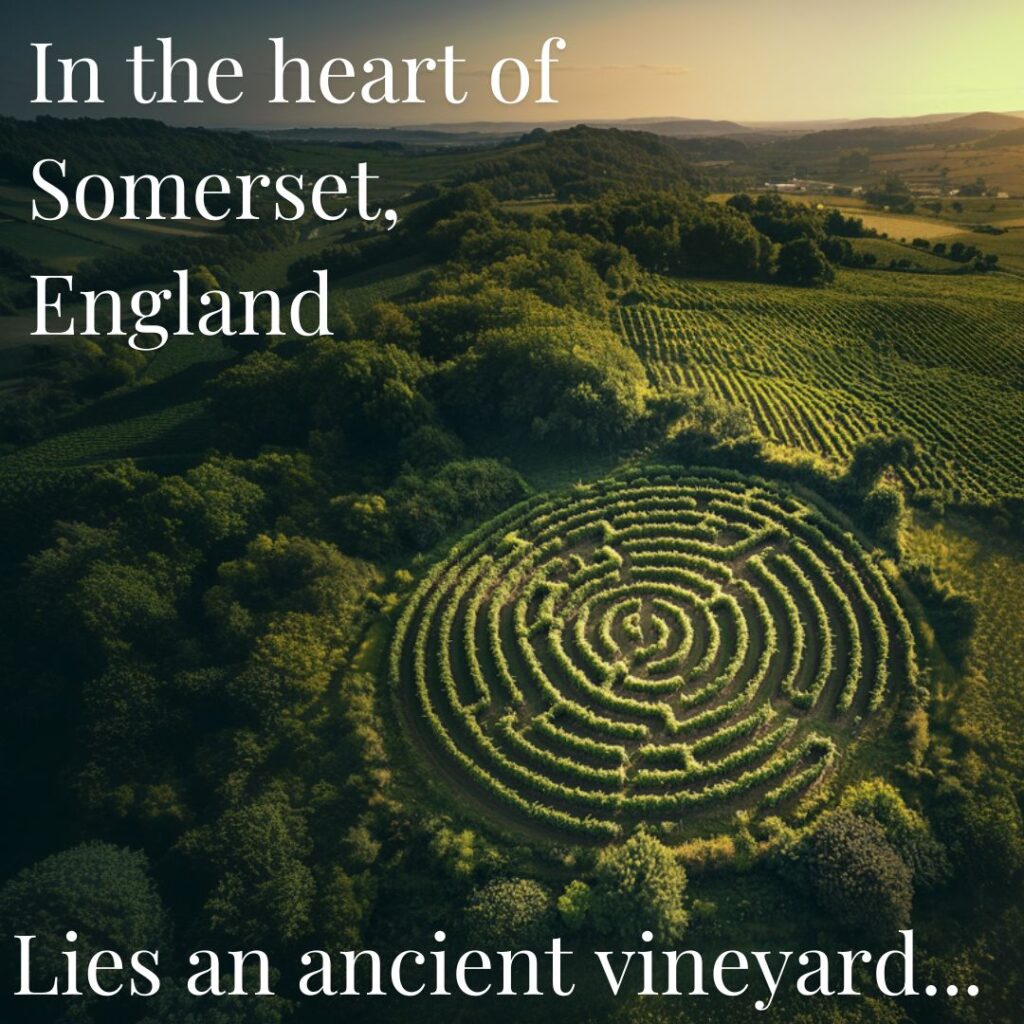
Natalie: There is a winery that has a labyrinth, but also I’m just working on a piece right now on wine and architecture and the Antonino Winery in Tuscany.
Italy has something like, it’s 11 hectares. I get acres and hectares mixed up, but the vines are growing on the roof and sides, the sangiovese vines, so it looks like it’s wrapped in this green cloak and, and the winery’s like rising up outta the land itself.
Jo: That is wonderful. I love architecture. I’ve got architects in so many of my books. I think in another life I would’ve been an architect.
Natalie: Yes. Well, you have so many passions. That’s what makes you a great writer. You pursue, and I was impressed with just how much you dove into the wine making and even in our exchanges leading up to this, beyond the book itself. So that’s what keeps you going.
What was the most difficult part of writing this book?
Jo: Well, I did love the research, but it got really difficult, and in fact the biggest change I had to make was the description of the grapes at the different types of the year. I had to even change when the book started. I had it originally starting in February and my beta readers said, you can’t have frost candles before bud break. That doesn’t make sense.
So I had to change that, but it was really interesting, and difficult to try and do all of that research and get it right, but also with biodynamics, I was having to try and work out like, how the hell, what kind of moon do you need on what kind of fruit day and what day of the month would this be? What would the grapes look like?
There was a whole year I had to map out, the viticulture year, the pagan year, the biodynamic year, like there was a lot of trying to get things right and again, I have to apologize in advance. I’m bound to have got something wrong, but I really did try.
Natalie: That’s okay. That’s all right. Well, between that and the whole architecture thing, you’re ready to open your own winery.
Jo: well, you know, when I’m rich, I’ll just open one.
Natalie: That’s right. Sit back on your beautiful veranda and your white dress, flowy dress and your chardonnay and Absolutely.
I’m intrigued though, too, Jo, you are launching this book not through traditional methods, but by Kickstarter. It’s a crowdfunding platform that people associate often with music, technology, and other products or projects.
Why did you choose Kickstarter to launch this book?
Jo: Well, the main reason is the Special Hardback Edition.
Natalie: It’s beautiful.
Jo: It’s got silver foil on it, a ribbon. It’s got also foil on the inside. It’s got custom wine end papers. It’s basically got a lot of the things that are very expensive to print, but also that you can’t just get from a book on Amazon. It is a special, special edition.
These will be First Editions, they’ll be signed and there will only be a short run. And essentially that’s why I do Kickstarter because what it enables me to do is essentially like pre-orders. People order the book and they pay on Kickstarter, and then I get the money and I put the order into the printer.
It kind of turns around the order of getting the money, otherwise it’s very hard as an independent to put the money down, get the books printed at this level of quality.
Oh, I forgot to show you the sprayed edges. So it’s got green edges and that’s beautiful. That is, I mean, you will hardly find any traditionally published books that have this kind of level of production, Of quality of printing.
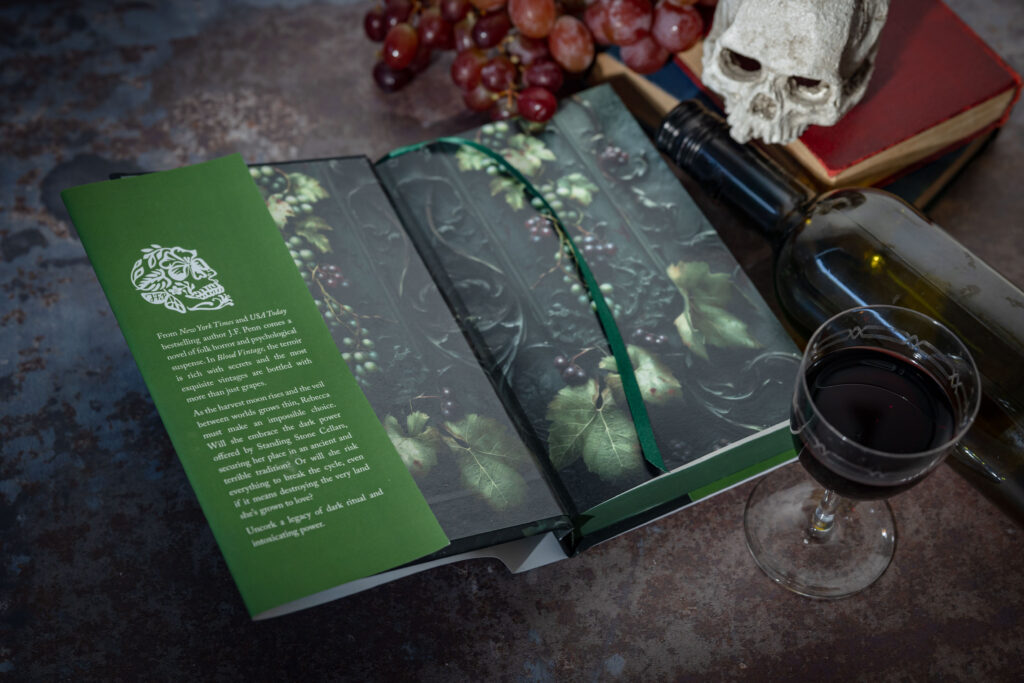
And so I want, this is why I love doing Kickstarter. It means I can make beautiful books. And I was thinking about this from the, from the wine point of view is the labelling. The packaging. Some of them have these lovely gift boxes. You know, shapes of bottles, the color of the bottles.
We, we have to think about the packaging. Absolutely. And so the packaging of this book was just so important to me. Um, and also like, I love making art and I made this. Image of the horn.
Natalie: The image is fantastic. Describe that for podcast listeners.
Jo: It’s basically a horned skull and the horns are actually like the moon ’cause I wanted to reflect the biodynamics. And then there’s kind of bloody grapes and bloody grape vines around it.
Natalie: It’s actually beautiful. It’s not gory at all. It’s just stunning.
Jo: Oh, thank you. It’s a piece of art and I actually think this could be a wine label.
Natalie: It does look a bit like that. Yeah, absolutely.
But you are right, the packaging matters. This would be a beautiful gift, a gift book as we come up to the holidays. But also, we eat and drink with our eyes first. That beautiful packaging, it just builds the anticipation. Like if there’s a beautifully gift wrapped present under the tree. It adds that touch. ’cause it engages all the senses. Not just taste and smell, but the eyes and the touch and everything else.
Jo: Yes, and I think as artists, we want to make beautiful objects.
And I mean like wine, it’s a physical product by its very nature, it’s a physical product. You can’t do digital wine, not at the moment anyway. You can’t plug yourself into the matrix and have digital wine, maybe one day.
But at the moment, I feel like for me, Kickstarter is really important to me to make beautiful art. And of course the book’s going to be on Kindle and audio at some point, and that is digital and the story will be the same, but the packaging is not the same.
But I think we’re at this point in the industry, and maybe it’s the same for vineyards, it’s hard to do marketing. So you have to think about ways to engage readers in a sensory way like vineyards do.
I mean, there’s a reason you go to tastings. It’s so you can engage with the product. And that’s how I really feel Kickstarter is serving creatives.
Natalie: Yes. And it is like being a patron of the arts, the callback to the Medici where people actually funded projects because they want to see independent writers or artists or musicians continue with the work, especially when they’re not on a mass commercial scale, and don’t aspire to be John Grisham or Danielle Steele or whatever. They want to create these beautiful art objects and artisanal stories.
Jo: Oh, you know, one day when I am [as famous as] Stephen King, these might be worth something.
Natalie: That’s true. Invest. Now you heard it here first.
Jo: But I guess, for a vineyard, they do small batches. Is it batches? Would that be a similar thing?
Natalie: Sure, small runs, small batches. Absolutely. And it’s that limitedness that makes it rare and makes people chase after certain bottles, even more at auction and different places.
What makes a successful Kickstarter? You can use this one as an example. I know you’ve done several others, but it’s not just the book that people buy. How do you entice them to engage in your Kickstarter?
Jo: Yes. Well, this is definitely, the visuals are really important. So I have made a book trailer, which is a video where you can soar over the labyrinth vineyard and see a bit of the bonfires and all of that kind of thing.
And then, there’ll be me talking about it. I know vineyard owners and winemakers are doing this too. Coming on your podcast and doing things to kind of get the human angle out there.
With the rise of ai, I know you’ve talked about AI and wine on the show, we have to stand out. We have to say, what is special about being human?
Kickstarter is very much about human creation.
And of course this (skull) image, I made this with AI, I made this with Midjourney and I love using the tools, but I use them to enhance and amplify my creative voice in the same way that vintners would use the tools of a vineyard to enhance their wine and get their product out there.
So I don’t see it as anything different. Engaging visuals tell a compelling story. So telling you that I really care about art and showing people that’s what you care about.
because yes, we’d like to make some money. Everyone would like to make some money, that’s how we continue making our art or our wine, but that’s not the entire reason for sure.
It’s about making something beautiful. It’s about engaging with backers.
So if you do back a Kickstarter, you basically get access to the creator.They talk to you and it’s more of a relationship and you also get to support them. So actually during the pandemic, I was part of an angel wine thing. You put in money to vineyards and you just got sent wine. This Kickstarter is kind of that.
Go browse on Kickstarter.com, help creators and get something awesome.
For my book, go to JFPenn.com/bloodvintage.
I’ll be doing this for just a couple of weeks, then the book will be available in different ways later on.
Natalie: We are publishing this on October 2nd 2024, you launched your Kickstarter October 1st, and it’s over by October 15th. So folks, if you want to participate, get in there quickly.
Wow, that, that the time just flew here. Let me round up with a few last questions.
If you could share a bottle of wine with any person in the world, who would that be and in which bottle would you open with them?
Jo: Well, I am very much inspired by the Swiss psychologist, Carl Jung. I studied Psychology of Religion and his work has inspired my fiction. Stone of Fire, and Crypt of Bone have a lot of Jung in, but also my nonfiction book, Writing the Shadow: Turn Your Inner Darkness Into Words, which is about tapping into the shadow, the dark side.
And there’s a heck of a lot of shadow in the wine industry. You and I will have to talk about that.
So Carl Jung, obviously now dead, but he wrote about wine as a metaphor for transformation of base into gold. The repressed self. A lot about mythology. A lot about folklore.
[I was thinking of his book, Psychology and Alchemy, but Jung didn’t specifically talk about wine.]
What do you drink with Carl Jung? He did a lot of stone carving, and again on architecture, he had a tower in Bollingen, on Lake Zurich, I looked for some wine in that region and there’s a wine called Chasselas.
Natalie: I think it’s a bright white.
Jo: Yes, a white wine, and I would put that with a cheese platter, maybe raclette, you know, the melted cheese that you kind of have in that area. And I would ask him, ’cause I’m turning 50 next year and I would like to ask him about the challenges of midlife. In midlife, he had a bit of a breakdown and he wrote The Red Book, and I’ve got a copy.
It’s this huge oversized book. And he did paintings and he just wrote journals and he was just deep in midlife crisis. And so I love that. I think it’s really interesting. We think of him in academia, but he was just deeply in life.
Natalie: That sounds great. I love that, and as we wrap up, is there anything that we haven’t covered that you’d like to mention?
Jo: As someone who is just a normal wine person, I think I’d really encourage people to try different kinds of wine without being scared of it.
And I feel like sometimes when normal people like me listen to wonderful writers like yourself about wines, we feel maybe a bit stupid in a way. Like, I can’t try that, or I can’t taste that. But what I’ve discovered I think by visiting these smaller vineyards is just try some stuff that’s a bit out of your comfort zone.
And it might be super, super interesting, like the orange wine. I’d never tried these sort of volcanic orange wines, and even if you can’t describe them very well, it doesn’t matter.
I think supporting the vineyards, supporting the viticulture industry is just as important as supporting the authors and the artists and the writers out there, and it’s a difficult time for everyone, and hopefully we can all support each other.
I absolutely loved writing this book. I love delving into the wine industry, and I appreciate all of you a lot more.
Natalie: Great. And my advice would be parallel to yours if try something outside your reading genre like folk horror.
I was pleasantly surprised. It was like the, whatever the funky Chardonnay I’d never tried before, it was great. I loved it. It expanded my horizons. Where can people best get in touch with you, Jo?
Jo: The book is at JFPenn.com/bloodvintage and since you’re listening to a podcast and if you want to write, The Creative Penn Podcast, and Natalie is going to be on my show soon, so you can find her there in a couple of months time.
Instagram @jfpennauthor, you can find lots of photos that also go with the book, including those vineyards, which I hope people will check out.
Natalie: Absolutely. That sounds like a lot of fun. Well, great, Jo, this has been fantastic. I loved it. I can’t believe how fast the time went, but thank you. Next time it has to be over a glass of wine in person.
Jo: Oh, oh, absolutely.
Natalie: Maybe in the part of the vineyard where we’re not allowed to go ’cause we’re just rebels that way.
Jo: Well, thanks so much for having me, Natalie. That was great.
Natalie: All right. I raise my glass to you. Cheers. Cheers. Bye.
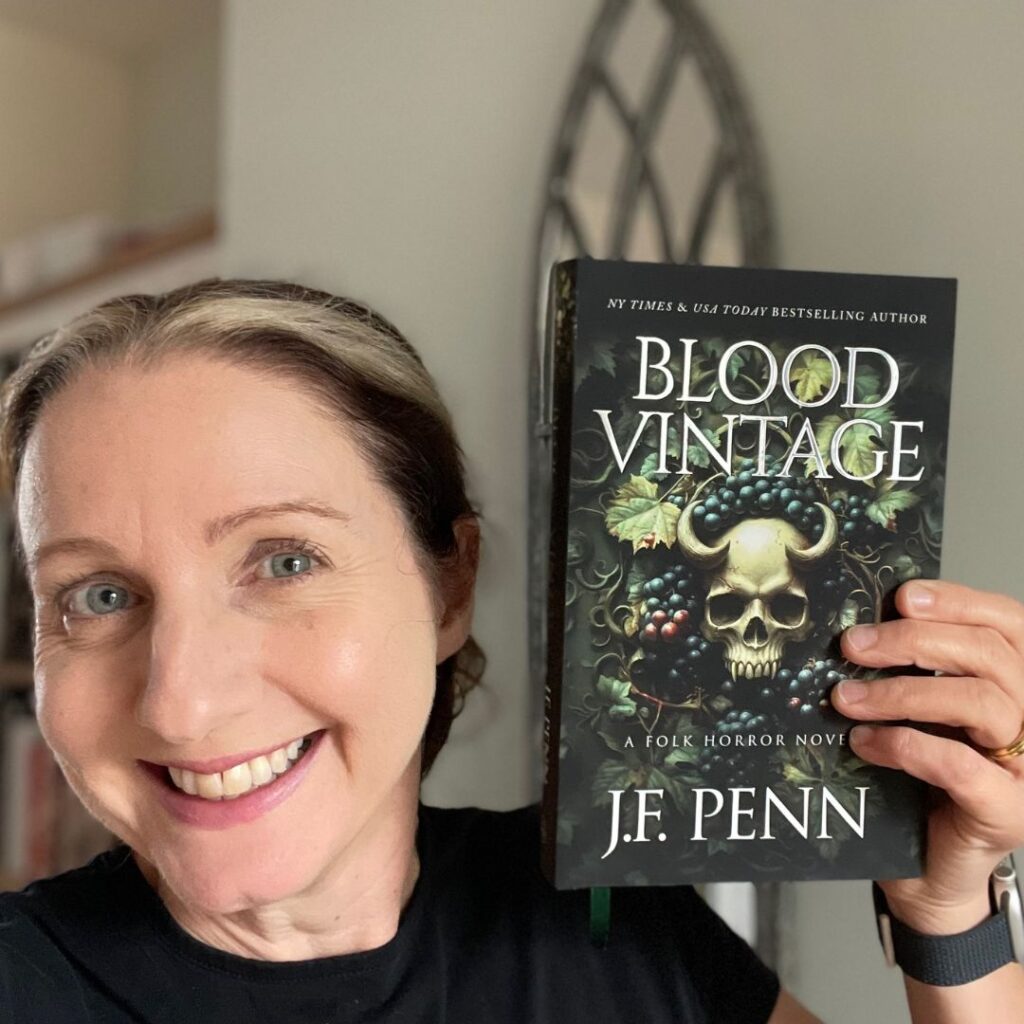

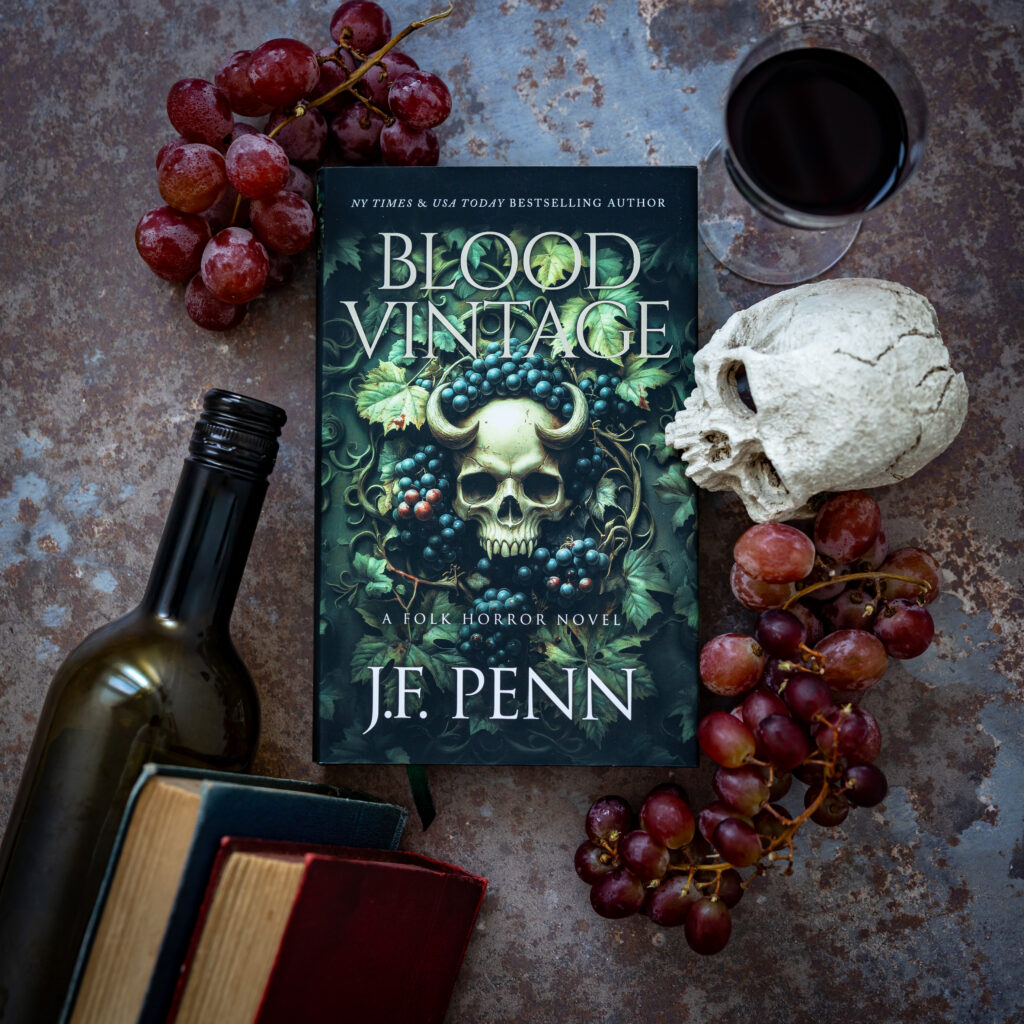
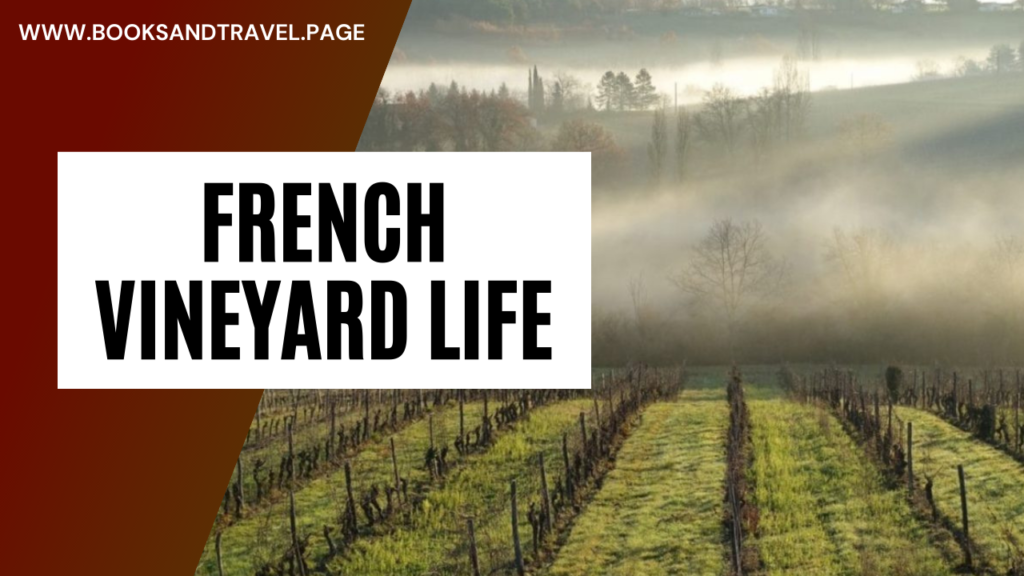
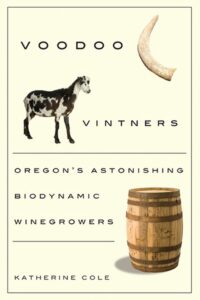
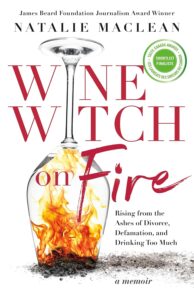

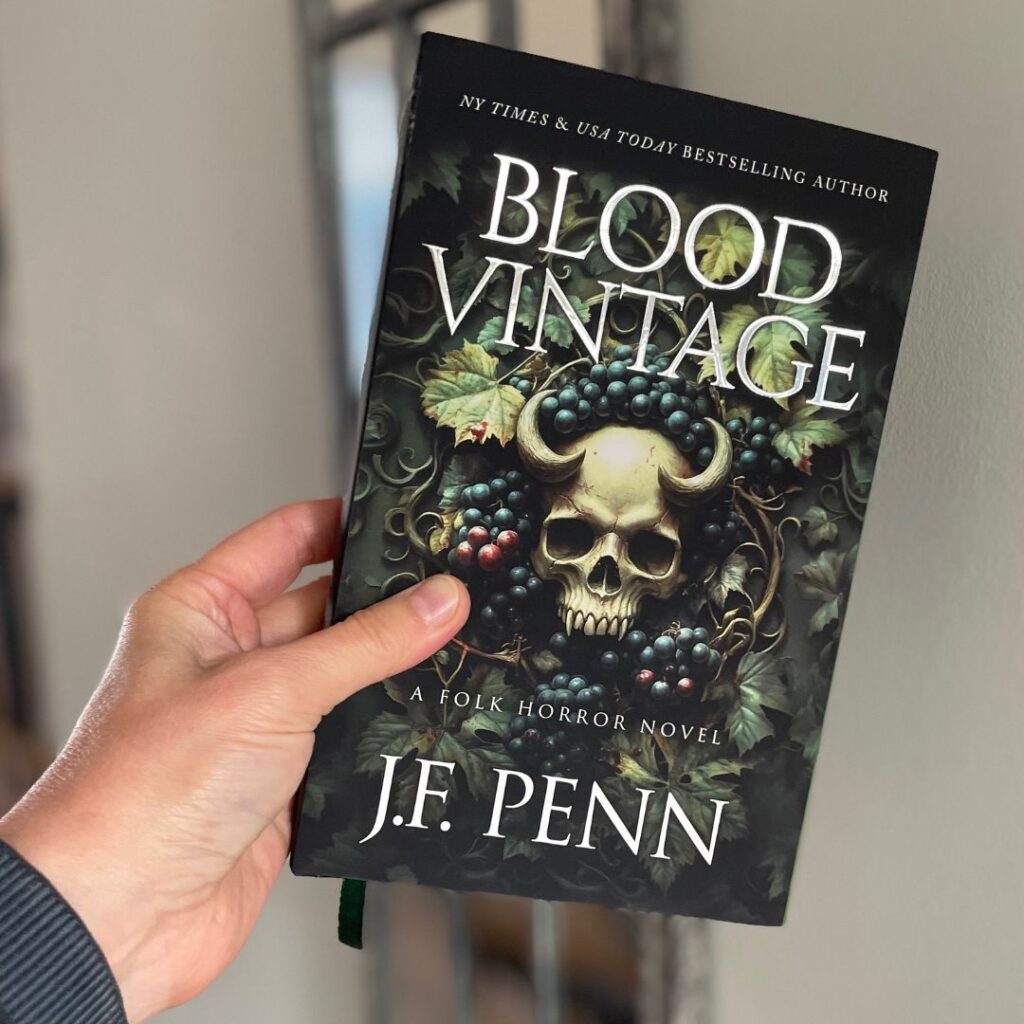
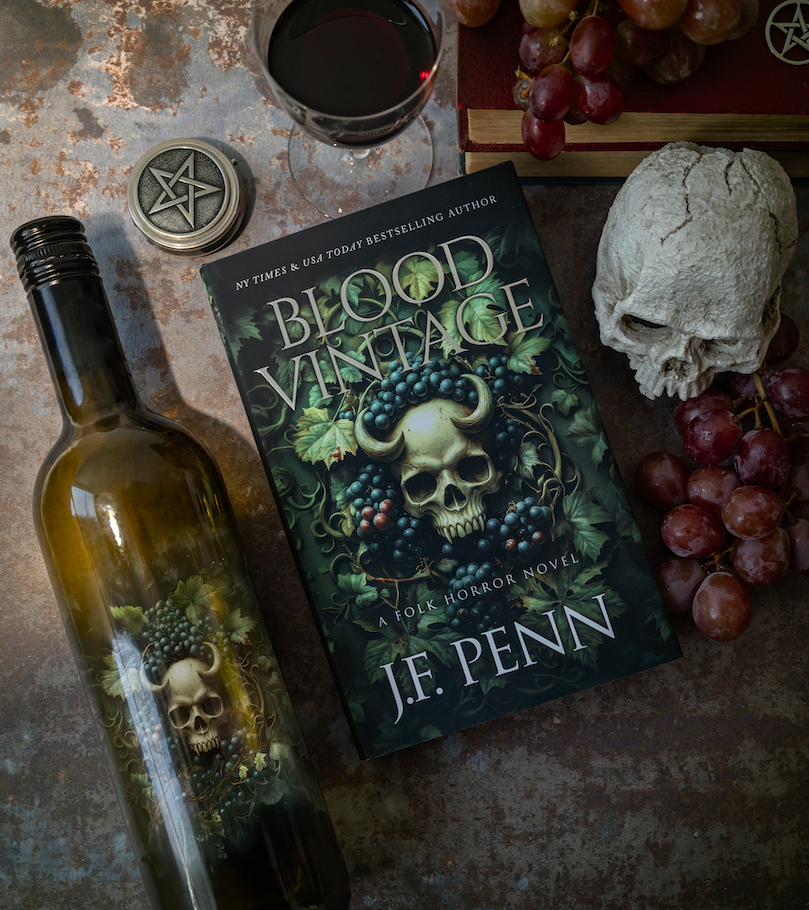
[…] You can listen to the full interview on your favourite podcast app, or here, and you can read the transcript of the full interview here with pictures. […]